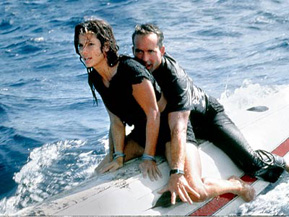|
|
Chapter TwoSpeed 2: Cruise ControlBy Brett Ballard-BeachAugust 18, 2011
Also, at this point, there is nothing that anyone on board can do - the prior sequence is one of the ship being agonizingly turned starboard manually to avoid a head-on collision with an oil tanker and it does pack a visual wallop - so the audience is also treated to stunned reaction shots of the passengers and crew, alternated with stunned reaction shots of the locals on land for what amounts to nearly ten minutes of interminable “so-what” destruction. Two thoughts kept running through my head during this and other sequences involving the imperiled passengers. The first was that for all its millions of dollars, there is a certain shoddiness that hangs over much of Speed 2, ultimately rendering it as a particularly low-rent version of the “disaster flick” sub-genre (nothing in Speed 2 wasn’t done at least as entertainingly in something like Airport ’77). My other musing concerned how the Steven Spielberg who helmed 1941 might have handled the destruction for destruction’s sake. Casting Willem Dafoe as John Geiger, the disgruntled computer whiz seeking revenge on the employer who terminated him when he became sick, seems a foolproof path to action movie nirvana. Giving him leeches that he self-administers to help suck out his poisoned blood screams over-the-top-camp. And yet, the film bobbles his character arc. Early on, he seems weird but not evil enough.
|

|
|
|

|
Thursday, May 2, 2024
© 2024 Box Office Prophets, a division of One Of Us, Inc.


